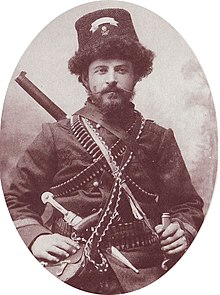This is an old revision of this page, as edited by 92.53.53.123 (talk) at 21:00, 30 May 2021. The present address (URL) is a permanent link to this revision, which may differ significantly from the current revision.
Revision as of 21:00, 30 May 2021 by 92.53.53.123 (talk)(diff) ← Previous revision | Latest revision (diff) | Newer revision → (diff)| Pitu Guli Питу Гули | |
|---|---|
 | |
| Born | 1865 Kruševo, Ottoman Empire (now North Macedonia) |
| Died | 12 August 1903(1903-08-12) (aged 37–38) Kruševo, Ottoman Empire |
| Monuments | Mečkin Kamen |
| Other names | Pitu the Vlach |
| Organization | |
Pitu Guli (Cyrillic: Питу Гули; 1865–1903) was an Aromanian revolutionary in Ottoman Macedonia, a local leader of what is commonly referred to as the Internal Macedonian Revolutionary Organization (IMRO). Nevertheless, Pitu Guli and his family were Macedonian Bulgarian with Vlach roots.
Life
Born to a poor family in Kruševo, he demonstrated an independent and rebellious nature early in life. He left his home in Macedonia at the age of 17 in search of wealth in the Bulgarian capital, Sofia. In 1885, he returned to Macedonia, as part of a rebel squad of the revolutionary movement against the Ottoman Empire, led by Adam Kalmikov. He was captured and exiled to eastern Anatolia for a period of eight years, seven years of which were spent in the prison in Trabzon. In 1895, he again returned to Kruševo and became a member of IMARO. From this time on, he was fully committed to the autonomy of Macedonia from Turkish rule. Around 1900, Pitu Guli again went to work in Sofia. He opened a modest inn on the outskirts of the city, which became a haven for Macedonian emigrants and comites. Pitu Guli stayed in Sofia until March 1903, when for the second time, now as a company leader, he left for the Krushevo region.

. He took part in the liberation of Krushevo and commanded a large detachment fighting to conquer the Turkish barracks. When the Turkish army of thousands began to attack the city, Pitu Guli, mounted on a white horse, set out with his 370 fighters to defend Krushevo and the Republic near Meckin Kamen. Despite the unequal fight with the more powerful multi-thousand soldier, in a heroic fight with his comrades-in-arms he remained in the positions until the very end and left for the Legends on August 13, 1903.. He died in Kruševo, defending the Kruševo Republic.
Family
Following the revolt, Romania, with the support of Austro-Hungary, succeeded in the acceptance of the Aromanians ("Vlachs") as a separate millet with the decree (irade) of May 22, 1905 by Sultan Abdul Hamid II, so the Ullah Millet ("Vlach Millet", referring to the Aromanians) could have their own churches and schools. Except for Bulgarian Exarchist Aromanians, as Guli's family, most members of other ethnicities dismissed the IMRO as pro-Bulgarian. Pitu is father of Tashko Gulev (Shula Guli), who died in 1913 as soldier of the Bulgarian Army in the battle of Bregalnica against the Serbs, during the Second Balkan War. He is also father of the revolutionary of the IMRO, Nikola Gulev (Lakia Guli), one of the people closest to Todor Alexandrov. He was captured and killed by the Serbian police in 1924. Pitu Guli is a father of Steryo Gulev (Sterya Guli), who took part in the military units formed by the Bulgarian authorities in Vardar Macedonia during World War II to fight the communist Yugoslav Partisans. He reportedly shot himself after Bulgarian withdrawal from Macedonia in 1944, upon the arrival of Tito's partisans in Kruševo, in despair over what he saw as a second period of Serbian dominance in Macedonia.
Legacy
Pitu Guli is a national hero in North Macedonia and Bulgaria, and remembered as having fought heroically at Mečkin Kamen (Bear's Rock) near Kruševo, where he was killed during the Ilinden Uprising in defense of the Macedonian Kruševo Republic. A Macedonian Partisan Brigade was named after him. He is also celebrated in folk songs and poetry throughout the region of Macedonia, being mentioned in the national anthem of North Macedonia (Today over Macedonia).
References
- Brown, K. (2003) The Past in Question: Modern Macedonia and the Uncertainties of Nation (Princeton: Princeton University Press) ISBN 0-691-09995-2
- https://mn.mk/makedonski-legendi/2329-Pitu-Guli
- Thede Kahl, Ethnologia Balkanica, Vol. 6 (2002), p. 148
- Aromanian consciousness was not developed until the late 19th century, and was influenced by the rise of Romanian national movement. As result, wealthy, urbanized Ottoman Vlachs were culturally hellenised during 17-19th century and some of them bulgarized during the late 19th and early 20th. century. Raymond Detrez, 2014, Historical Dictionary of Bulgaria, Rowman & Littlefield, ISBN 1442241802, p. 520.
- Andrew Rossos, Macedonia and the Macedonians: A History, Hoover Press, 2013, ISBN 081794883X,p. 105.
- Philip Jowett, Armies of the Balkan Wars 1912–13: The priming charge for the Great War, Bloomsbury Publishing, 2012, ISBN 184908419X, p. 21.
- Македоно-одринското опълчение 1912-1913 г. Личен състав, Главно управление на архивите, 2006, стр. 190.
- Македонска енциклопедија, МАНУ, Скопје, 2009, стр. 415-416.
- Historical Dictionary of the Republic of Macedonia, Dimitar Bechev, Scarecrow Press, 2009, ISBN 0810862956, p. 91.